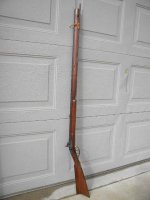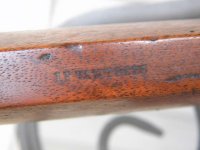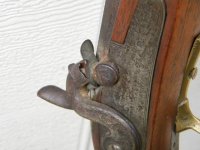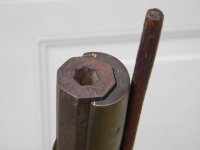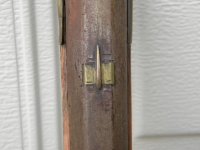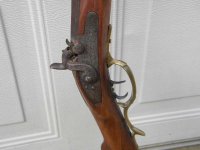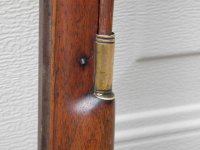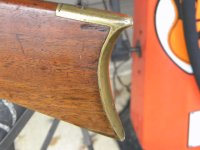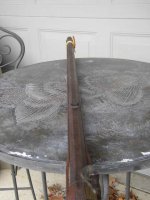One of my co-workers asked me to do a little research for him. He has an old muzzleloader and it is as such:
I think it is a Kentucky Longrifle or Pennsylvania Rifle
32 1/2 long, rifled (I think), heavy, octagonal barrel. It appears as though there are some sort of dimples on the bottom like they are flashings from a mold. Cap and ball , set triggers (if I know what that really means). Does that mean you pull the curved trigger so the hammer will engage and then pull the straight trigger to fire? Anyway, it has a severely curved brass buttplate and a cheek rest. The sights are dovetailed, but the rear sight is gone. The forearm extends to about halfway up the barrel and has a cap on the muzzle end, and the ramrod goes in the forearm cap and into the forearm. The diameter of the bore is about 3/8 inch.
It has a brass trigger guard with curved finger rests on the bottom that extend about an inch.The steel lockplate(?) is engraved with a a pointer dog pointing at some unknown animal. It also has leaves and grasses engraved on the plate surrounding the scene.
It is engraved with the words: g.g. julcher ( I think)
Any Ideas what this thing is?
[Edited by tatters on 11-17-2000 at 08:32 PM]
I think it is a Kentucky Longrifle or Pennsylvania Rifle
32 1/2 long, rifled (I think), heavy, octagonal barrel. It appears as though there are some sort of dimples on the bottom like they are flashings from a mold. Cap and ball , set triggers (if I know what that really means). Does that mean you pull the curved trigger so the hammer will engage and then pull the straight trigger to fire? Anyway, it has a severely curved brass buttplate and a cheek rest. The sights are dovetailed, but the rear sight is gone. The forearm extends to about halfway up the barrel and has a cap on the muzzle end, and the ramrod goes in the forearm cap and into the forearm. The diameter of the bore is about 3/8 inch.
It has a brass trigger guard with curved finger rests on the bottom that extend about an inch.The steel lockplate(?) is engraved with a a pointer dog pointing at some unknown animal. It also has leaves and grasses engraved on the plate surrounding the scene.
It is engraved with the words: g.g. julcher ( I think)
Any Ideas what this thing is?
[Edited by tatters on 11-17-2000 at 08:32 PM]

